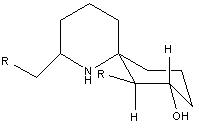It:Histrionicotoxin
Appearance
Histrionicotoxin is a poison. In 1823 Captain Charles Stuart Cochrane discovered tribes of Indians native to Colombia using it for hunting. They used the poison for the tips of their arrows and blowguns. He discovered that the poison was extracted from small yellow brightly coloured frogs called Dendrobates histrionicus.
Uses
They have been found to be potent inhibitors of the acetyl choline receptor channel and as such constitute important synthetic targets.

| Histrionicotoxin | |||||||
|---|---|---|---|---|---|---|---|

|
|||||||
| Empirical formula | C19H25N1O1 | ||||||
| calculated density | 1.122 g/cm3 | ||||||
| Other Name | (-)-Histrionicotoxin] | ||||||
| Molecular formula | C19H25N1O1 | ||||||
| Molar mass | 283.414 g/mol | ||||||
| CAS number | 13774-81-7 | ||||||
| Appearance | yellow liquid | ||||||
| Properties | |||||||
| Density and phase | 0.780 g/cm3 | ||||||
| Solubility in water (ph=7) | |||||||
| Melting point | 15-17°C | ||||||
| Boiling point | decomposes | ||||||
| Acidity (pKa) | |||||||
